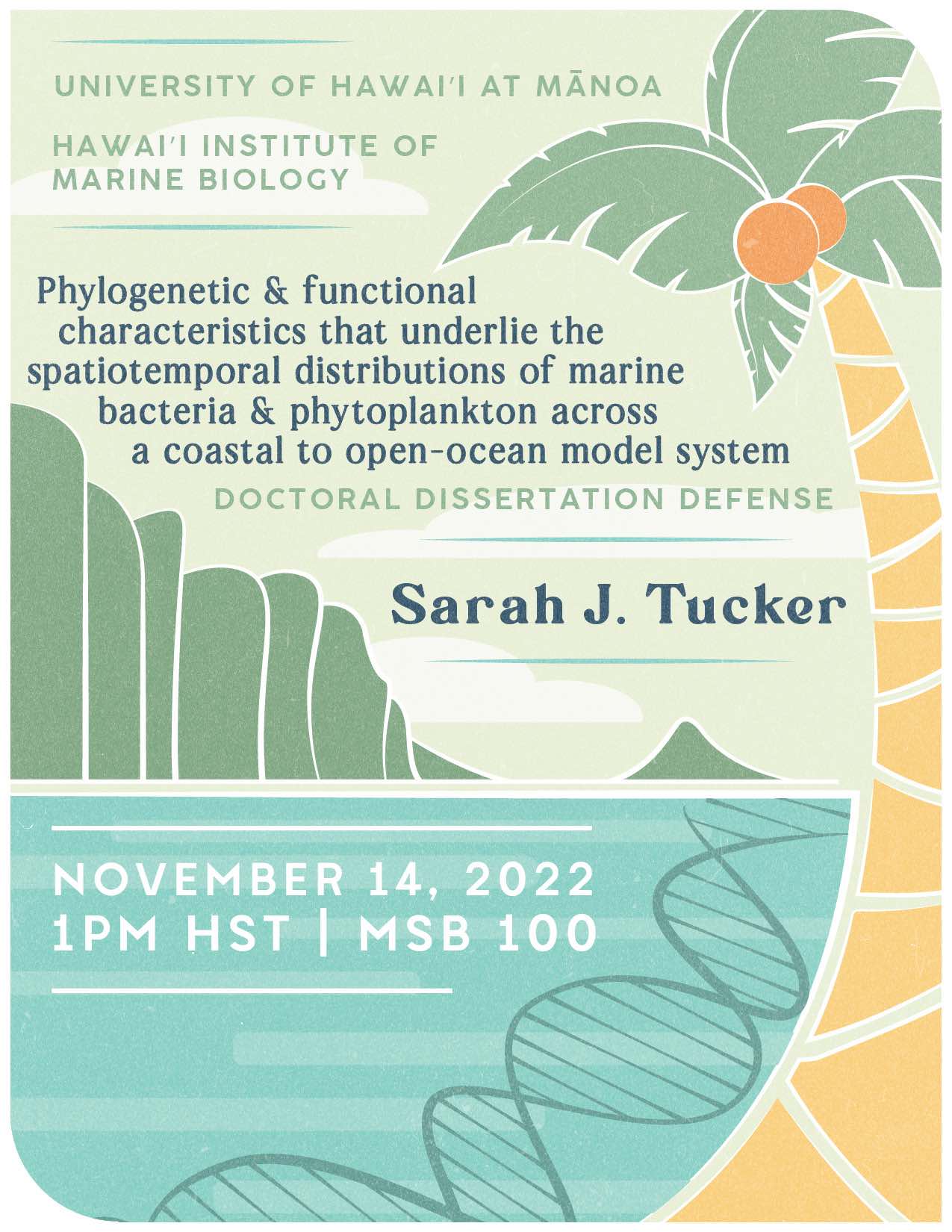MBGP Dissertation Defense for Sarah J. Tucker
November 14, 1:00pm - 2:00pmMānoa Campus, Marine Sciences Building 100, Zoom Meeting ID: 956 1283 9471 Passcode: 143333
Abstract: Understanding the roles that marine microbes play in ecosystem functioning has been historically difficult in large part because of the immense genetic and ecological diversity found within natural populations. This dissertation research characterized the steep physical and biogeochemical gradients found across Kāneʻohe Bay, Oʻahu, Hawaiʻi, and surrounding offshore waters, and used this system as a model platform to examine the genetic diversity, population structure, and metabolic potential of marine microorganisms. Time-series analyses across this system revealed that an increase in inorganic nutrient concentrations within the near-shore environment of coastal Kāneʻohe Bay co-varied with elevated phytoplankton biomass of up to ~1800% compared to open-ocean waters of the North Pacific Subtropical Gyre. Steep gradients in environmental parameters and phytoplankton biomass coincided with shifts in phytoplankton community composition and diversity, including the abundance and population structure of numerically abundant picocyanobacteria. The steep physical and biogeochemical gradient also impacted the distribution of subclades and genome clusters within the abundant alphaproteobacterial lineage known as SAR11. Seven of eight SAR11 subclades detected in this system were distributed nonuniformly across the coastal to offshore environments within and adjacent to Kāneʻohe Bay. Pangenomic analyses with metagenomes and a collection of high-quality SAR11 Ia genomes from strains recently isolated from this system revealed the hallmarks of ecotypic differentiation: distinct distributions, the accumulation of differences in metabolic gene content, and the cohesion of both ecological and genetic diversity within SAR11 Ia genome clusters. The utilization of data collected through both the Kāneʻohe Bay Time-series (KByT) and the Hawaii Ocean Time-series (HOT) provided the unique opportunity to elucidate the genetic, genomic, and metabolic variability of surface ocean microbial populations across narrow (<6km) and broad (>100km) spatial scales in the tropical Pacific. In sum, this dissertation provides insight into the forces that contribute to the genetic and ecological diversity of dominant and biogeochemically relevant lineages of marine bacteria.
Event Sponsor
Marine Biology Graduate Program, Mānoa Campus
More Information
Sarah J Tucker, 4133588918, tucker4@hawaii.edu
Monday, November 14 |
|
| 10:00am |
La'au Lapa'au Demonstration West Oʻahu Campus, UHWO Garden
|
| 10:00am |
Storytime in the Garden Mānoa Campus, 3860 Manoa Rd
|
| 12:00pm |
Second Language Studies Final Oral Mānoa Campus, Moore 155A (in-person), Zoom: https://hawaii.zoom.us/j/95439571458
|
| 12:45pm |
Honolulu Community College International Education Week 2022 Honolulu Campus, 874 Dillingham Blvd
|
| 1:00pm |
Marine Biology Final Oral Mānoa Campus, Marine Sciences Building 100
|
| 1:00pm |
MBGP Dissertation Defense for Sarah J. Tucker Mānoa Campus, Marine Sciences Building 100, Zoom Meeting ID: 956 1283 9471 Passcode: 143333
|
| 3:30pm |
Miyazaki/Shinkai Anime Workshop West Oʻahu Campus, A116
|
| 3:30pm |
MIEW: Study Away Student Panel Mānoa Campus, Zoom
|


